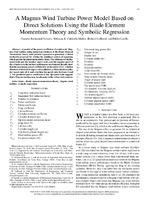A Magnus Wind Turbine Power Model Based on Direct Solutions Using the Blade Element Momentum Theory and Symbolic Regression

View/
Date
2017-01Author
Richmond-Navarro, Gustavo
Calderón-Muñoz, William
LeBoeuf, Richard
Castillo, Pablo
Metadata
Show full item recordAbstract
A model of the power coefficient of a mid-scale Magnus wind turbine using numerical solutions of the Blade Element Momentum Theory and symbolic regression is presented. A direct method is proposed for solving the nonlinear system of equations which govern the phenomena under study.The influence of the tip speed ratio and the number, aspect ratio, and the angular speed of the cylinder son the turbine performanceisobtained. Results show that the máximum power coefficientisontheorderof 0.2, whichis obtained witht wolowa spectratio cylinders, adimension lesscy linder speed ratio of 2, and a turbine tip-speed ratio between 2 and 3. The predicted power coefficient at low tip-speed ratio suggests that a Magnus turbine may be adequate in the urban environment.
Source
Richmond-Navarro,Gustavo, Calderón-Muñoz, William, LeBoeuf, Richard and Castillo, Pablo "A Magnus Wind Turbine Power Model Based on Direct Solutions Using the Blade Element Momentum Theory and Symbolic Regression" IEEE Transaction on Sustainable Energy, volumen 8, no 1, January, 2017.Share
Metrics
Collections
- Artículos [6]

